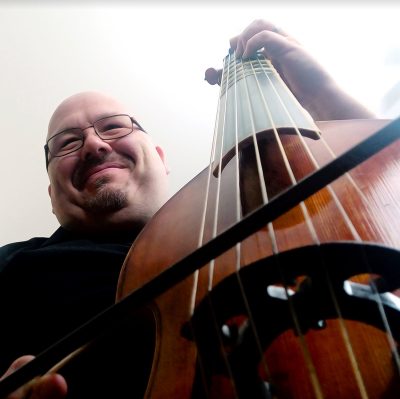by Karen Cook
Published December 20, 2021

Claudia Francesca Rusca: Canzoni Francesi à4 (Milan, 1630). Phillip W. Serna, treble, tenor, and bass viols, and lute. Self-published.
For most of the last two years, performing in ensembles has been a challenge, to say the least. From teaching on Zoom to rehearsing or recording online, music-making in the time of lockdown often became a solitary experience, even when technically — or rather, technologically — with others. While some turned that solitary time into an exploration of music for solo instrument, others harnessed the new possibilities today’s technology has to offer and tackled polyphony on their own. This latest release by gambist Phillip Serna shows off the musical powers of multi-tracking to solid success.

An EP (extended play recording), Serna’s newest release contains but two tracks, albeit ones with fascinating parentage. These two canzonas are nestled among a host of sacred vocal works in Sacri concerti à 1–5 con salmi e canzoni francesi (1630), a collection penned by the Italian nun Claudia Francesca Rusca (1583–1676); the canzonas are thus the earliest known instrumental works published by a woman. Rusca had studied composition and performance at home before becoming a nun at the Umiliate monastery of S Caterina in Brera, alongside a number of her aunts, cousins, and sisters.
At the monastery, she not only sang but acted as organist and music teacher, as well as composing; the collection in question was designed specifically to suit the musical practices then prevalent at her convent and others. Rusca dedicated it to Archbishop Federico Borromeo (after whom the first canzon, “La Borromea,” is presumably named), in honor of his known affection and support for female monastics. In a poignant connection to the context in which they were recorded, the works were published during the Great Plague of Milan. Unfortunately, the only known copy of this print was destroyed in 1943 in the fire at the Biblioteca Ambrosiana, but surviving pre-war photographs permitted the creation of a modern edition.

Both of these charming canzonas are performed on treble, tenor, and bass viol, plus lute, all of which are performed by Serna himself. This allows for a really consistent and unified approach to phrasing, cadences, and overall stylistic interpretation, which is especially nice given how highly imitative these works are. Canzon prima “La Borromeo” is stately but with pep and some fun dynamic contrasts, while the lush Canzon seconda has a lovely sense of forward motion interrupted only briefly by a moment of beautiful homophonic playing.
The bass viol has a slightly greater presence in the rich second canzon, which makes me want to hear it a bit more in the mix on the first. However, I enjoy how clearly the timbre of the lute cuts through the texture of the viols, and the playing on both is convincing. Serna deserves some serious credit, not just for the fine quality of the playing but also the skill demonstrated in the multitracking and the cleanness and clarity of the overall production. Given that Rusca did not compose any more instrumental works, and more’s the pity there, I hope Serna turns his attention and skill to yet more underrepresented composers in the near future.
Karen Cook specializes in the music, theory, and notation of the late medieval and early Renaissance periods. She is assistant professor of music at the University of Hartford in Connecticut.




